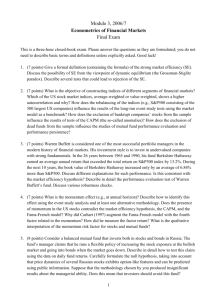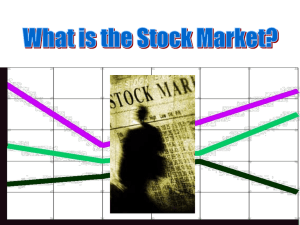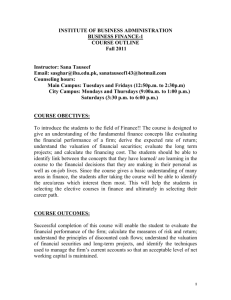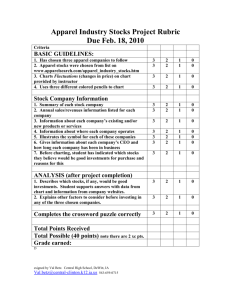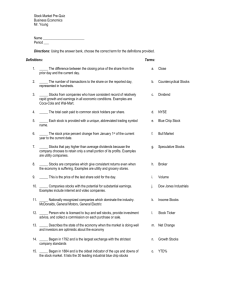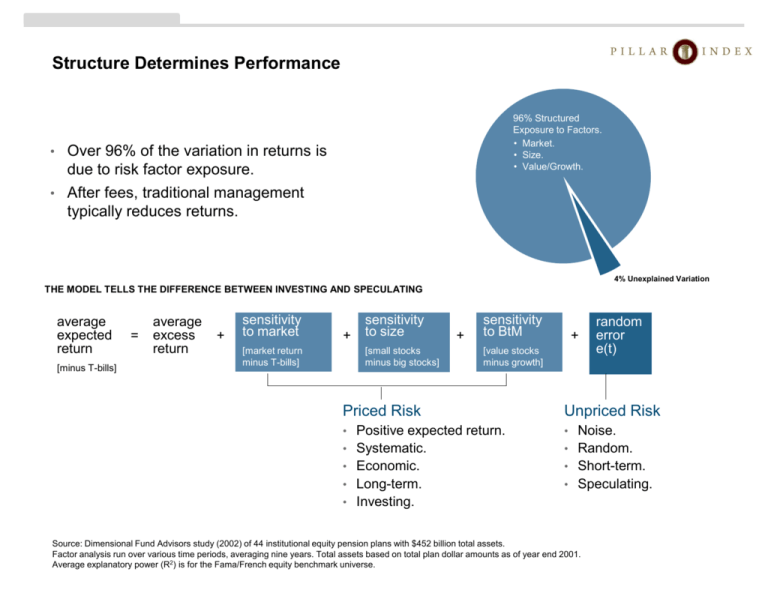
Structure Determines Performance
96% Structured
Exposure to Factors.
• Market.
• Size.
• Value/Growth.
• Over 96% of the variation in returns is
due to risk factor exposure.
• After fees, traditional management
typically reduces returns.
4% Unexplained Variation
THE MODEL TELLS THE DIFFERENCE BETWEEN INVESTING AND SPECULATING
average
expected
return
[minus T-bills]
=
average
excess
return
+
sensitivity
to market
[market return
minus T-bills]
+
sensitivity
to size
[small stocks
minus big stocks]
+
sensitivity
to BtM
+
[value stocks
minus growth]
random
error
e(t)
Priced Risk
Unpriced Risk
• Positive expected return.
• Noise.
• Systematic.
• Random.
• Economic.
• Short-term.
• Long-term.
• Speculating.
• Investing.
Source: Dimensional Fund Advisors study (2002) of 44 institutional equity pension plans with $452 billion total assets.
Factor analysis run over various time periods, averaging nine years. Total assets based on total plan dollar amounts as of year end 2001.
Average explanatory power (R2) is for the Fama/French equity benchmark universe.
Risk and Return Are Related
Small
Three Dimensions of Stock Returns around the World
• Equity Market
(complete value-weighted universe of stocks)
Stocks tend to have higher expected returns
than fixed income over time.
• Company Size
(measured by market capitalization)
Small company stocks tend to have higher
expected returns than large company stocks
over time.
• Company Price
(measured by ratio of company book value to
market equity)
Lower-priced “value” stocks tend to have higher
expected returns than higher-priced “growth”
stocks over time.
Increased Risk
Exposure and
Expected Return
Value
Growth
Decreased Risk
Exposure and
Expected Return
Total
Stock
Market
Large
Eugene F. Fama and Kenneth R. French, “The Cross-Section of Expected Stock Returns,” Journal of Finance 47, no. 2 (June 1992): 427-65.
Eugene F. Fama and Kenneth R. French are consultants for Dimensional Fund Advisors. This page contains the opinions of Eugene F. Fama and Kenneth R. French but not
necessarily of Dimensional Fund Advisors or DFA Securities LLC, and does not represent a recommendation of any particular security, strategy, or investment product. The
opinions expressed are subject to change without notice. This material is distributed for educational purposes only and should not be considered investment advice or an
offer of any security for sale. Dimensional Fund Advisors (“Dimensional”) is an investment advisor registered with the Securities and Exchange Commission. All materials
presented are compiled from sources believed to be reliable and current, but accuracy cannot be guaranteed. This article is distributed for educational purposes, and it is not
to be construed as an offer, solicitation, recommendation, or endorsement of any particular security, products or services described. ©2011 by Dimensional Fund Advisors.
All rights reserved.
Five Factors Help Determine Expected Return
Annual Average Returns
1927–2010
8.04%
4.90%
3.75%
2.11%
0.30%
Market
Factor
Size
Factor
BtM
Factor
Maturity
Factor
Default
Factor
All Equity
Universe
minus T-Bills
Small Stocks
minus
Large Stocks
High BtM
minus
Low BtM
LT Govt.
minus
T-Bills
LT Corp.
minus
LT Govt.
Equity factors provided by Fama/French. Fixed factors provided by Ibbotson Associates.
Indices are not available for direct investment. Their performance does not reflect the
expenses associated with the management of an actual portfolio.
Yearly Observations of the US Market Premium
Market minus One-Month Treasury Bills
1927-2010
Average
Within 2% of Average
Premiums within Range
8.04%
2010
Data provided by Fama/French. Total US Market Research Factor (total market minus one-month Treasury bills).
Past performance is not a guarantee of future results. Values change frequently and past performance may not be repeated. There is always the risk that an investor may
lose money. Securities of small firms are often less liquid than those of large companies. As a result, small company stocks may fluctuate relatively more in price. Even a
long-term investment approach cannot guarantee a profit. Economic, political, and issuer-specific events will cause the value of securities, and the funds that own them, to
rise or fall. Because the value of investments will fluctuate, there is a risk that investors will lose money.
Yearly Observations of the US Value Premium
Value Stocks minus Growth Stocks
1927-2010
Average
Within 2% of Average
Premiums within Range
4.90%
2010
Multifactor data provided by Fama/French.
Past performance is not a guarantee of future results. Values change frequently and past performance may not be repeated. There is always the risk that an investor may
lose money. Securities of small firms are often less liquid than those of large companies. As a result, small company stocks may fluctuate relatively more in price. Even a
long-term investment approach cannot guarantee a profit. Economic, political, and issuer-specific events will cause the value of securities, and the funds that own them, to
rise or fall. Because the value of investments will fluctuate, there is a risk that investors will lose money.
Yearly Observations of the US Size Premium
Small Stocks minus Big Stocks
1927-2010
Average
Within 2% of Average
Premiums within Range
3.75%
2010
Multifactor data provided by Fama/French.
Past performance is not a guarantee of future results. Values change frequently and past performance may not be repeated. There is always the risk that an investor may
lose money. Securities of small firms are often less liquid than those of large companies. As a result, small company stocks may fluctuate relatively more in price. Even a
long-term investment approach cannot guarantee a profit. Economic, political, and issuer-specific events will cause the value of securities, and the funds that own them, to
rise or fall. Because the value of investments will fluctuate, there is a risk that investors will lose money.
Five-Year Moving Average of the US Size and Value Premiums
Annual: 1927–2010
US Size Premium
• On an annualized basis, small
cap and value stocks have had
more positive than negative
five-year periods relative to
large cap and growth stocks.
• These periods typically offer
stronger performance relative to
large cap and growth.
• Small cap and value stocks are
still subject to extended periods
of underperformance.
2010
US Value Premium
2010
Multifactor data provided by Fama/French. SmB and HmL research factors.
Past performance is not a guarantee of future results. Values change frequently and past performance may not be repeated. There is always the risk that an investor may
lose money. Securities of small firms are often less liquid than those of large companies. As a result, small company stocks may fluctuate relatively more in price. Even a
long-term investment approach cannot guarantee a profit. Economic, political, and issuer-specific events will cause the value of securities, and the funds that own them, to
rise or fall. Because the value of investments will fluctuate, there is a risk that investors will lose money.
Five-Year Moving Average of the US Market Premium
Annual: 1927–2010
2010
Data provided by Fama/French. Total US Market Research Factor (total market minus one-month Treasury bills).
Past performance is not a guarantee of future results. Values change frequently and past performance may not be repeated. There is always the risk that an investor may
lose money. Securities of small firms are often less liquid than those of large companies. As a result, small company stocks may fluctuate relatively more in price. Even a
long-term investment approach cannot guarantee a profit. Economic, political, and issuer-specific events will cause the value of securities, and the funds that own them, to
rise or fall. Because the value of investments will fluctuate, there is a risk that investors will lose money.
The Risk Dimensions Delivered
July1926–December 2010
US Value vs. US Growth
US Small vs. US Large
Value beat growth 100% of the time.
Small beat large 96%
97% of the time.
Value beat growth 100% of the time.
Small beat large 83%
88% of the time.
Value beat growth 99%
95% of the time.
Small beat large 78%
82% of the time.
Value beat growth 96%
91% of the time.
Small beat large 68%
75% of the time.
Value beat growth 86%
82% of the time.
60% of
of the
the time.
time.
Small beat large 59%
OVERLAPPING PERIODS
Periods based on rolling annualized returns. 715 total 25-year periods. 775 total 20-year periods.
835 total 15-year periods. 895 total 10-year periods. 955 total 5-year periods.
Performance based on Fama/French Research Factors. Securities of small companies are often less liquid than those of large companies.
As a result, small company stocks may fluctuate relatively more in price. Mutual funds distributed by DFA Securities LLC.
The Risk Dimensions Delivered
January 1975–December 2010
January 1970–December 2010
International Value vs. International Growth
International Small vs. International Large
OVERLAPPING PERIODS
Value beat growth 100% of the time.
Small
Smallbeat
beatlarge
large100%
100%of
ofthe
thetime.
time.
Value beat growth 100% of the time.
Small
Smallbeat
beatlarge
large100%
97% of
of the
the time.
time.
Value beat growth 100% of the time.
Smallbeat
beatlarge
large84%
82%of
ofthe
thetime.
time.
Small
Value beat growth 100% of the time.
Smallbeat
beatlarge
large76%
78%of
ofthe
thetime.
time.
Small
Value beat growth 98% of the time.
Small
Smallbeat
beatlarge
large75%
78%of
ofthe
thetime.
time.
Based on rolling annualized returns. Rolling multi-year periods overlap and are not independent. This statistical dependence must be considered when
assessing the reliability of long-horizon return differences.
International Value vs. International Growth data: 133 overlapping 25-year periods. 193 overlapping 20-year periods. 253 overlapping 15-year periods. 313
overlapping 10-year periods. 373 overlapping 5-year periods. International Small vs. International Large data: 193 overlapping 25-year periods. 253
overlapping 20-year periods. 313 overlapping 15-year periods. 373 overlapping 10-year periods. 433 overlapping 5-year periods. International Value and
Growth data provided by Fama/French from Bloomberg and MSCI securities data. International Small data compiled by Dimensional from Bloomberg,
StyleResearch, London Business School, and Nomura Securities data. International Large is MSCI World ex USA Index gross of foreign withholding taxes
on dividends; copyright MSCI 2011, all rights reserved.
Large Stocks vs. Fixed Income
Monthly: January 1926-December 2010
Rolling Time Periods
Total Number of Periods
Number of Periods
S&P 500 Index
Outperformed One-Month T-Bills
1 Year
3 Years
5 Years
10 Years
15 Years
20 Years
30 Years
40 Years
1009
985
961
901
841
781
661
541
686
731
724
751
797
781
661
541
100%
100%
95%
100%
83%
68%
74%
75%
Percentage of All Rolling Periods Where S&P 500 Index Outperformed One-Month T-Bills
The S&P data are provided by Standard & Poor’s Index Services Group. One-Month Treasury Bills © Stocks, Bonds, Bills, and Inflation Yearbook™, Ibbotson Associates,
Chicago (annually updated work by Roger G. Ibbotson and Rex A. Sinquefield). Indexes are not available for direct investment. Their performance does not
reflect the expenses associated with the management of an actual portfolio. Past performance is not a guarantee of future results. Values change
frequently and past performance may not be repeated. There is always the risk that an investor may lose money. Even a long-term investment approach
cannot guarantee a profit. Economic, political, and issuer-specific events will cause the value of securities, and the portfolios that own them, to rise or fall.
Because the value of your investment in a portfolio will fluctuate, there is a risk that you will lose money. Indexes are referred to for comparative purposes
only and do not represent similar asset classes in terms of components or risk exposure; thus, their returns may vary significantly. The S&P 500 Index
measures the performance of large cap US stocks. One-Month T-Bills measure the performance of US government-issued Treasury bills.
Value Stocks vs. Large Stocks
Monthly: July1926-December 2010
Rolling Time Periods
Total Number of Periods
Number of Periods
US Large Value Index
Outperformed S&P 500 Index
1 Year
3 Years
5 Years
10 Years
15 Years
20 Years
30 Years
40 Years
1003
979
955
895
835
775
655
535
589
599
601
627
655
609
579
523
98%
88%
78%
79%
70%
59%
61%
63%
Percentage of All Rolling Periods Where US Large Value Index Outperformed S&P 500 Index
US Large Value Index is Fama/French US Large Value Index (ex utilities), provided by Fama/French. The S&P data are provided by Standard & Poor’s Index Services
Group. Indexes are not available for direct investment. Their performance does not reflect the expenses associated with the management of an actual portfolio.
Past performance is not a guarantee of future results. Values change frequently and past performance may not be repeated. There is always the risk that an investor
may lose money. Even a long-term investment approach cannot guarantee a profit. Economic, political, and issuer-specific events will cause the value of securities,
and the portfolios that own them, to rise or fall. Because the value of your investment in a portfolio will fluctuate, there is a risk that you will lose money. Indexes are
referred to for comparative purposes only and do not represent similar asset classes in terms of components or risk exposure; thus, their returns may vary significantly.
The S&P 500 Index measures the performance of large cap US stocks. US Large Value Index measures the performance of US stocks with lower price-to-book ratios.
Small Stocks vs. Large Stocks
Monthly: January 1926-December 2010
Rolling Time Periods
Total Number of Periods
Number of Periods
US Small Cap Index
Outperformed S&P 500 Index
1 Year
3 Years
5 Years
10 Years
15 Years
20 Years
30 Years
40 Years
1009
985
961
901
841
781
661
541
541
512
546
570
598
634
605
541
100%
92%
81%
71%
63%
54%
57%
52%
Percentage of All Rolling Periods Where US Small Cap Index Outperformed S&P 500 Index
The S&P data are provided by Standard & Poor’s Index Services Group. CRSP data provided by the Center for Research in Security Prices, University of
Chicago. Indexes are not available for direct investment. Their performance does not reflect the expenses associated with the management of an actual portfolio.
Past performance is not a guarantee of future results. Values change frequently and past performance may not be repeated. There is always the risk that an
investor may lose money. Even a long-term investment approach cannot guarantee a profit. Economic, political, and issuer-specific events will cause the value of
securities, and the portfolios that own them, to rise or fall. Because the value of your investment in a portfolio will fluctuate, there is a risk that you will lose money.
Securities of small companies are often less liquid than those of large companies. As a result, small company stocks may fluctuate relatively more in price.
Indexes are referred to for comparative purposes only and do not represent similar asset classes in terms of components or risk exposure; thus, their returns may
vary significantly. The S&P 500 Index measures the performance of large cap US stocks. The CRSP 6-10 Index measures the performance of US small cap
stocks, those in the five smallest deciles of the US market.
Distribution of the US Market Premium
1927–2010
1931
2008
1974
1937
1930
1973
2002
2001
2000
1981
1969
1929
1990
1966
1962
1957
1984
1977
1970
1946
1941
1940
1932
1994
1987
1960
1953
2007
2005
1978
1948
1947
1939
1934
1993
1992
1986
1982
1968
1959
1956
2006
2004
1988
1983
1979
1972
1971
1965
1964
1952
2010
1998
1996
1963
1951
1949
1942
Average Annual Premium:
8.04%
Green and orange years indicate 1990s and 2000s respectively.
Data provided by Fama/French. Total US market research factor (total market minus one-month Treasury bills).
1999
1989
1985
1980
1976
1967
1961
1955
1944
1997
1991
1950
1943
1938
2009
2003
1995
1975
1936
1927
1945
1928
1958
1935
1954
1933
Distribution of the US Value Premium
1927–2010
1999
1980
1934
1939
1931
2007
1991
1971
1938
1930
2009
1998
1990
1969
1967
1960
1957
1953
1951
1928
Average Annual Premium:
4.90%
Green and orange years indicate 1990s and 2000s respectively.
Data provided by Fama/French. HmL research factor.
2010
1994
1989
1987
1979
1966
1956
1949
1940
1937
1927
2008
2003
1996
1995
1985
1978
1972
1959
1952
1948
1946
2005
2004
1986
1977
1975
1965
1962
1961
1955
1947
1932
2006
2002
1997
1988
1982
1974
1964
1958
1945
1941
1935
1929
2001
1993
1984
1973
1968
1963
1944
1942
1933
1992
1983
1976
1970
1981
1954
1950
1936
1943
2000
Distribution of the US Size Premium
1927–2010
1998
1929
1973
1990
1989
1987
1972
1970
1969
1937
Average Annual Premium:
3.75%
2007
1995
1986
1984
1963
1962
1955
1952
1948
1947
2005
2000
1997
1996
1994
1974
1964
1960
1957
1956
1954
1953
1951
1946
1941
1930
1927
Green and orange years indicate 1990s and 2000s respectively.
Data provided by Fama/French. SmB research factor.
2008
2006
2004
2002
1985
1966
1961
1950
1949
1940
1931
1928
2009
1993
1992
1988
1982
1981
1980
1971
1959
1942
1939
1935
1932
2010
1999
1983
1978
1976
1958
1938
2001
1991
1975
1944
1936
1979
1977
1968
1965
2003
1945
1934
1943
1967
1933
Historical US Value and Small Cap Premiums
Annual
Value minus Growth
Top 30% – Bottom 30%
Small minus Large
Bottom 50% – Top 50%
Average
Premium (%)
Standard
Deviation (%)
Average
Premium (%)
Standard
Deviation (%)
July 1926–June 2010
6.44
27.84
5.45
23.84
July 1946–June 2010
4.53
13.97
2.88
13.18
July 1975–June 2010
3.97
15.22
3.53
13.57
Data provided by Fama/French.
Size and Value Effects Are Strong around the World
Annual Index Data
Annualized
Compound
Returns (%)
US
Large
Value
US
S&P Large
500 Growth
US
US
Small CRSP Small
Value
6-10 Growth
Intl.
Value
Intl. MSCI
Intl.
Small EAFE Growth
Emg.
Markets
Value
Emg.
Markets
“Market”
Emg.
Markets
Growth
US Large
Capitalization Stocks
1927–2010
US Small
Capitalization Stocks
1927–2010
14.03
11.88
11.35
19.17
15.98
13.95
18.48
19.17
13.67
11.29
25.01
21.98
19.46
17.05
Standard Deviation (%) 27.01
20.51
21.93
35.13
30.94
34.05
24.56
28.13
22.29
22.21
42.01
40.67
36.40
34.89
Average Return (%)
Non-US Developed
Markets Stocks
1975–2010
Emg.
Markets
Small
Emerging
Markets Stocks
1989–2010
In US dollars. Indices are not available for direct investment. Their performance does not reflect the expenses associated with the management of an actual portfolio. Past
performance is not a guarantee of future results. US value and growth index data (ex utilities) provided by Fama/French. The S&P data are provided by Standard & Poor’s
Index Services Group. CRSP data provided by the Center for Research in Security Prices, University of Chicago. International Value data provided by Fama/French from
Bloomberg and MSCI securities data. International Small data compiled by Dimensional from Bloomberg, StyleResearch, London Business School, and Nomura Securities
data. MSCI EAFE Index is net of foreign withholding taxes on dividends; copyright MSCI 2011, all rights reserved. Emerging markets index data simulated by Fama/French
from countries in the IFC Investable Universe; simulations are free-float weighted both within each country and across all countries.
Indexes are not available for direct investment. Their performance does not reflect the expenses associated with the management of an actual portfolio.
Past performance is not a guarantee of future results. Values change frequently and past performance may not be repeated. There is always the risk that an investor may
lose money. Small company risk: Securities of small firms are often less liquid than those of large companies. As a result, small company stocks may fluctuate relatively more
in price. Emerging markets risk: Numerous emerging countries have experienced serious, and potentially continuing, economic and political problems. Stock markets in many
emerging countries are relatively small, expensive, and risky. Foreigners are often limited in their ability to invest in, and withdraw assets from, these markets. Additional
restrictions may be imposed under other conditions. Foreign securities and currencies risk: Foreign securities prices may decline or fluctuate because of: (a) economic or
political actions of foreign governments, and/or (b) less regulated or liquid securities markets. Investors holding these securities are also exposed to foreign currency risk (the
possibility that foreign currency will fluctuate in value against the US dollar).

